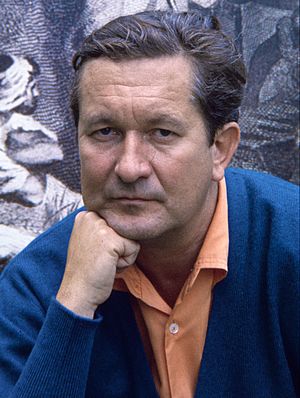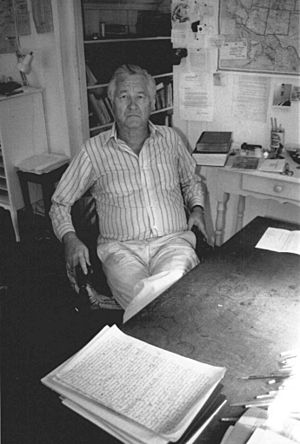William Styron facts for kids
Quick facts for kids
William Styron
|
|
|---|---|

William Styron, 1967
|
|
| Born | William Clark Styron Jr. June 11, 1925 Newport News, Virginia, U.S. |
| Died | November 1, 2006 (aged 81) Martha's Vineyard, Massachusetts, U.S. |
| Occupation | Novelist, essayist |
| Alma mater | Duke University |
| Period | 1951–2006 |
| Notable works | Lie Down in Darkness The Confessions of Nat Turner Sophie's Choice Darkness Visible |
| Spouse |
Rose Burgunder
(m. 1953) |
| Children | 4, including Alexandra |
| Signature | |
 |
|
William Clark Styron Jr. (born June 11, 1925 – died November 1, 2006) was an American writer. He wrote many novels and essays. He won important awards for his books.
Styron was famous for his novels. These include:
- Lie Down in Darkness (1951). This was his first book. He was 26 years old when it was published.
- The Confessions of Nat Turner (1967). This book is told by Nat Turner. He led a slave revolt in Virginia in 1831.
- Sophie's Choice (1979). This story is about a young writer. He meets a Polish Catholic woman who survived Auschwitz. He also meets her smart but troubled Jewish boyfriend.
In 1985, William Styron experienced a serious period of depression. After he got better, he wrote a book about it. This book was called Darkness Visible (1990). It became very well-known in the later part of his life.
Contents
Early Life and Education
William Styron was born in Newport News, Virginia. His parents were Pauline Margaret Abraham and William Clark Styron. He grew up in the Southern United States. He learned a lot about its history. His birthplace was close to where Nat Turner's slave rebellion happened. This event later inspired one of his most famous books.
Styron's mother was from the North. His father was from the South and had open-minded views. This gave him a wide view on race. His childhood was not easy. His father, an engineer, had clinical depression. William Styron would later experience this himself. His mother died from breast cancer in 1939. Styron was still a boy at the time.
Styron went to public schools in Warwick County. He then attended Christchurch School. This was a special school that prepared students for college. Styron once said he had "true and abiding affection" for Christchurch.
After school, Styron went to Davidson College. He started reading writers who would influence him. One important writer was Thomas Wolfe. In 1943, Styron moved to Duke University. He was part of a U.S. Navy program. There, he published his first short story. He wrote several more stories for the university's literary magazine. Styron became a lieutenant in the United States Marine Corps. However, World War II ended before he went to fight. He finished his English degree at Duke in 1947.
Writing Career and Travels
After college, Styron worked as an editor in New York City. He did not enjoy this job. He later wrote about how unhappy he was in his book Sophie’s Choice. After being fired, he started writing his first novel.
Three years later, he published Lie Down in Darkness (1951). This book was about a family in Virginia. Critics loved the novel. For this book, Styron won the Rome Prize.
Military Service and The Long March
The Korean War caused Styron to be called back into the military. This stopped him from taking his Rome Prize right away. He joined the Marine Corps again. But he was discharged in 1952 due to eye problems. He used his experiences in the Marines to write The Long March. This short novel was published in 1953. It was later made into a TV episode in 1958.
Life in Europe
Styron spent a long time living in Europe. In Paris, he became friends with other writers. These included James Baldwin and George Plimpton. In 1953, this group started a magazine called The Paris Review. It became a very famous literary magazine.
Also in 1953, Styron finally used his Rome Prize. He traveled to Italy. There, he met Truman Capote. At the American Academy in Rome, he met Rose Burgunder again. She was a poet from Baltimore. They had met before at Johns Hopkins University. They got married in Rome in the spring of 1953.
Some of Styron's time in Europe inspired his third book. It was called Set This House on Fire (1960). This novel was about Americans living in Italy. The book got mixed reviews in the United States. But in Europe, its French translation became a bestseller.
Sophie's Choice
Styron's next novel was Sophie's Choice (1979). The book faced challenges and was even banned in some schools because of its difficult topics.
The story is about Sophie, a Polish Catholic who survived Auschwitz. It also features Nathan, her smart Jewish boyfriend who had a mental illness. And there is Stingo, a young writer from the South. He moves to Brooklyn after World War II and falls in love with Sophie. The book won the 1980 National Book Award. It was also a nationwide bestseller.
A movie version was made in 1982. It was nominated for five Academy Awards. Meryl Streep won the Academy Award for Best Actress for playing Sophie.
Darkness Visible
More people started reading Styron's work after Darkness Visible was published in 1990. This book started as a magazine article. It tells the story of the author's deep struggle with depression. He describes a night of "despair beyond despair." It was a personal account of a serious depressive episode. The book helped people talk more openly about mental health issues.
Later Achievements and Honors
William Styron received many awards. He was given the St. Louis Literary Award in 1985. He also won the Prix mondial Cino Del Duca.
His short story "Shadrach" was made into a film in 1998. His daughter, Susanna Styron, helped direct it.
Other books he published include the play In the Clap Shack (1973). He also released a collection of his non-fiction writings called This Quiet Dust (1982).
The French President François Mitterrand honored Styron. He made him a Commander of the Legion of Honor. In 1993, Styron received the National Medal of Arts.
In 2002, an opera based on Sophie's Choice opened in London. The composer, Nicholas Maw, wrote the music and the story for the opera.
Styron's writings and papers are kept at Duke University. In 1996, he received the F. Scott Fitzgerald Award. He also won the Edward MacDowell Medal in 1988. He was a founding member of the Fellowship of Southern Writers.
Port Warwick Street Names
The Port Warwick neighborhood in Newport News, Virginia, is named after a city in Styron's novel Lie Down in Darkness. This neighborhood has a main square called William Styron Square. Its streets are named after characters from his novels, like Nat Turner Boulevard. Styron himself helped choose the names for the streets. He decided to "honor great American writers." So, there are streets named after Philip Roth, Thomas Wolfe, and Herman Melville.
Death
William Styron died from pneumonia on November 1, 2006. He was 81 years old. He passed away on Martha's Vineyard. He is buried in Vineyard Haven, Massachusetts.
Family Life
While in Italy, William Styron reconnected with Rose Burgunder, a poet. They got married in Rome in 1953. They had four children together. Their daughter Susanna Styron is a film director. Their daughter Paola is a famous dancer. Their daughter Alexandra is a writer. Their son Thomas is a professor of clinical psychology at Yale University.
See also
 In Spanish: William Styron para niños
In Spanish: William Styron para niños


